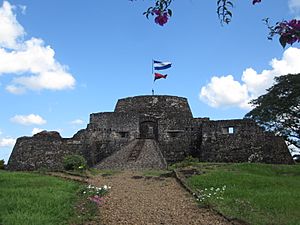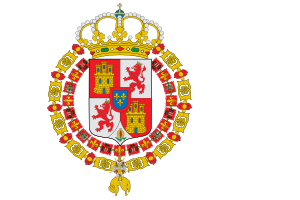Battle for Río San Juan de Nicaragua facts for kids
Quick facts for kids Battle for Río San Juan de Nicaragua |
|||||||
|---|---|---|---|---|---|---|---|
| Part of Anglo-Spanish War (1761–1763) | |||||||
 Fortress of the Immaculate Conception, site of the battle for Río San Juan de Nicaragua |
|||||||
|
|||||||
| Belligerents | |||||||
| Commanders and leaders | |||||||
| Strength | |||||||
| 2,000 | 100 | ||||||
| Casualties and losses | |||||||
| unknown (high) | unknown (low) | ||||||
The battle for Río San Juan de Nicaragua was an important fight during the Anglo-Spanish War. This war was part of the bigger Seven Years' War. The battle happened in July and August 1762. It started when William Lyttelton, the British governor of Jamaica, sent a group of ships and soldiers to Nicaragua. Their main goal was to capture the town of Granada.
Why the Battle Happened
Nicaragua was a big target for the British in the 1700s. This was because it offered a possible route between the Atlantic and Pacific oceans. It also meant they could expand their colonies in Central America.
Britain and the Miskito people had a special agreement. This agreement, signed in 1740, made the Mosquito Coast a British protectorate. Britain gave modern weapons to the Miskito people. The Miskito Kingdom later helped Britain attack Spanish colonies.
Spain stayed neutral when the Seven Years' War began in 1756. But things changed when a British ship captured a French ship. Spain got involved and sided with France. This alliance was called the Third Pacte de Famille. Spain's main goals were to capture Gibraltar and Jamaica from Britain.
Britain declared war on Spain in January 1762. Spain declared war back soon after. The British quickly captured Cuba and the Philippines. Around the same time, Governor William Lyttelton suggested the attack on Nicaragua. The plan was to sail up the San Juan River to Lake Nicaragua. Then they would capture Granada. This would split Spanish America in half. It would also give them access to the Pacific Ocean. The biggest challenge was taking the Fortress of the Immaculate Conception.
In June 1762, a group of Miskito fighters, helped by the British, attacked farms in Nicaragua. The next month, they raided many towns. They burned and looted villages. They also took some Spanish prisoners. These prisoners were sometimes sold into slavery in Jamaica.
The British and Miskito force then moved towards the Fortress of the Immaculate Conception. This was in July. The attacking force had 2,000 men and over 50 boats. The fortress only had about 100 soldiers. The commander of the fortress, Don José de Herrera y Sotomayor, was very sick. His daughter, Rafaela, promised him she would defend the fortress. Her father died around July 15-17. Lieutenant Don Juan de Aguilar y Santa Cruz took temporary command.
The Battle Begins
- Further information: Fortress of the Immaculate Conception and Rafaela Herrera
The attacking force reached the fortress on July 26, 1762. Early that morning, the fortress guards heard cannon fire. The invaders captured a nearby observation post. From the Spanish prisoners, the British learned that the fortress was in chaos. This was because its commander had just died.
A few hours later, the British commander sent a message. He demanded that the fortress surrender right away. He promised no more fighting if they gave up. The second-in-command was about to agree. But 19-year-old Rafaela Herrera stepped in. She saw the defenders acting scared. She told them: "Have you forgotten your duty? Will you let the enemy steal this fortress? It protects Nicaragua and your families!"
Inspired by her father, she strongly opposed giving up the fort. She insisted that every soldier fight. She ordered the fortress gates to be locked. She took the keys herself and placed guards.
The British were angry that their demands were refused. They formed a line, thinking this would be enough. But Herrera, who knew how to use weapons, fired a cannon. With her third shot, she killed a British officer.
The British raised their flag and attacked the fortress fiercely. The fight continued all night. The soldiers, encouraged by Herrera's bravery, fought back hard. They caused many losses for the British soldiers and their boats.
As night fell, Herrera ordered a clever move. She told the troops to throw sheets soaked in alcohol into the river. These sheets were on floating branches and set on fire. The river current carried the burning material towards the enemy boats. This surprise attack forced the British to stop their attack for the night. They pulled back to safer positions. The next day, the British tried to siege the fortress. But they made little progress.
Inspired by Herrera, Lieutenant Juan de Aguilar led the defenders to victory. The battle lasted six days. Herrera handled the cannons. The Spanish successfully defended their important position. The British finally stopped their siege on August 3, 1762. They were called away to other important parts of the Seven Years' War. They withdrew to the mouth of the San Juan River. Their presence there blocked shipping for some time.
What Happened Next
Luckily for the fortress defenders, Spain and Britain started talking about peace. They signed a peace treaty in Fontainebleau in November 1762. As part of the peace, Spain gave Florida to the British.
Later, in 1779, Spain joined the American Revolutionary War. Major General John Dalling, the British governor of Jamaica, planned another attack on Nicaragua. This happened in 1780. It is known as the San Juan Expedition. Colonel John Polson and Captain Horatio Nelson led a British attack against the fortress.
At that time, the Spanish fortress had 228 men. They were led by Juan de Ayssa. The British force had only 200 men. But they managed to capture the fortress on April 29, 1780. Nelson, who was 22 years old, led his men through thick jungle. They attacked the fortress from a hill behind it. The British held the fortress for nine months. They finally left it in January 1781.
See also
 In Spanish: Batalla del Río San Juan de Nicaragua para niños
In Spanish: Batalla del Río San Juan de Nicaragua para niños


